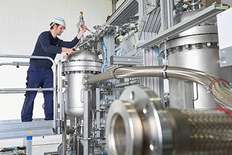- The H2FUTURE project has a budget of EUR 18 million, with EUR 12 million funded by the EU.
- The plant will have a capacity of 6 megawatts and produce 1,200 cubic meters of green hydrogen per hour.
- Construction started in early 2017, with the plant expected to be operational by spring 2019.
- The project aims to decarbonize steel production and integrate green hydrogen into power grids.

Project Overview
The EU-funded H2FUTURE project aims to create a CO2-reduced energy future and decarbonize steel production. The consortium, including voestalpine, Siemens, VERBUND, and Austrian Power Grid, has started constructing the world's largest green hydrogen pilot plant at the voestalpine site in Linz. The plant, with a capacity of 6 megawatts, is expected to be fully operational by spring 2019.
Investment and Funding
The project has a total budget of EUR 18 million, with EUR 12 million funded by the European Commission through the Fuel Cells and Hydrogen Joint Undertaking (FCH JU). This funding is part of the EU Horizon2020 program, aimed at demonstrating the feasibility of greening large industries like steelmaking.
Technological Milestones
The plant will use Siemens' PEM electrolyser module to produce 1,200 cubic meters of green hydrogen per hour, achieving an 80 percent efficiency in converting electricity into hydrogen. The hydrogen produced will be used in various industrial applications, including steel production, mobility, and energy storage.
Construction and Timeline
Construction began in early 2017, with the foundations and hall already in place. Core electrolysis components are expected to be delivered during the summer, and the plant will go live within a year. A comprehensive two-year test program will start in spring 2019 to explore the potential applications of green hydrogen.
Future Implications
The H2FUTURE project aims to reduce CO2 emissions by around 80 percent by 2050. It will test the integration of green hydrogen into various process stages of steel production and power reserve markets. The project is a significant step towards the energy transition and the decarbonization of the steel industry.

